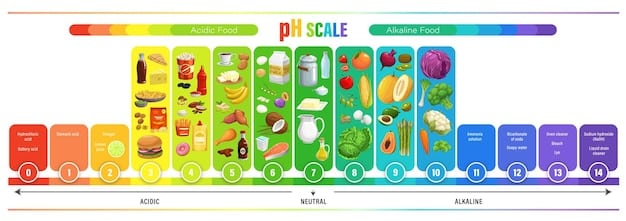Baby Feeding Schedules: Sample Plans for 6, 9, and 12-Month-Olds

Baby feeding schedules for 6, 9, and 12-month-olds provide structure and ensure nutritional needs are met during crucial developmental stages, transitioning from milk to solids while fostering healthy eating habits.
Navigating the world of baby feeding can feel overwhelming. Understanding appropriate baby feeding schedules: sample plans for 6, 9, and 12-month-olds can help guide you through these important developmental stages and ease the stress. Let’s explore how to create effective and balanced meal plans for your little one.
Understanding Baby Feeding Schedules
Creating a consistent feeding schedule for your baby is essential for their health and development. These schedules not only help ensure your baby receives adequate nutrition but also establish predictable routines that promote better sleep and overall well-being.
A structured approach to feeding can also make meal times less stressful for both you and your baby. It helps your baby understand when to expect food and can prevent constant snacking throughout the day.
Benefits of a Consistent Schedule
Having a well-defined schedule offers numerous advantages. It can improve your baby’s digestion, reduce fussiness, and make it easier to introduce new foods.
- Improved Digestion: Regular meal times allow the digestive system to work efficiently, breaking down food at consistent intervals.
- Reduced Fussiness: Babies thrive on predictability. Knowing when their next meal is coming can decrease anxiety and crying.
- Easier Food Introduction: A schedule provides a structured environment for introducing new textures and flavors.
Ultimately, a well-implemented feeding schedule can contribute to a happier, healthier baby and a more confident, relaxed parent.

6-Month-Old Feeding Schedule
At six months old, your baby is likely ready to start exploring solid foods in addition to breast milk or formula. This is a significant milestone in their development, and a well-planned feeding schedule can make this transition smoother.
Introducing solids at this stage helps meet their growing nutritional needs and prepares them for a broader range of foods in the future. Remember to consult with your pediatrician before introducing any new foods and to watch for any signs of allergies.
Sample 6-Month-Old Feeding Schedule
This sample schedule is designed to provide a balanced intake of nutrients while introducing your baby to solid foods gradually. Adjust timings and quantities based on your baby’s individual needs and cues.
- 7:00 AM: Breast milk or formula (6-8 oz)
- 10:00 AM: 2-4 tablespoons of single-ingredient pureed fruit (e.g., applesauce, banana)
- 1:00 PM: Breast milk or formula (6-8 oz)
- 4:00 PM: 2-4 tablespoons of single-ingredient pureed vegetable (e.g., sweet potato, carrots)
- 7:00 PM: Breast milk or formula (6-8 oz)
Be patient and observe your baby’s reactions to each new food. It may take multiple attempts for them to accept a new flavor or texture. Consistency is key, but don’t force them to eat if they are not interested.
9-Month-Old Feeding Schedule
By nine months, your baby is likely becoming more adventurous with food. They may be able to handle more textured foods and larger portions. Their feeding schedule should reflect these advancements.
At this stage, your baby’s nutritional needs are increasing, and they require a wider variety of nutrients to support their continued growth and development. Introducing a more diverse range of foods can help meet these needs and foster healthy eating habits.

Sample 9-Month-Old Feeding Schedule
This schedule includes three meals and two snacks, providing a balanced intake of nutrients. Always offer breast milk or formula as a primary source of nutrition, supplementing it with solid foods.
- 7:00 AM: Breast milk or formula (6-8 oz) + Oatmeal with pureed fruit
- 10:00 AM: Snack – Yogurt or soft fruit pieces
- 1:00 PM: Lunch – Pureed or mashed vegetables with protein (e.g., chicken, lentils)
- 4:00 PM: Snack – Small pieces of cheese or crackers
- 7:00 PM: Dinner – Mashed vegetables and protein + Breast milk or formula (6-8 oz)
Encourage your baby to self-feed by offering finger foods like cooked vegetable sticks, soft fruit pieces, and Cheerios. This helps them develop their fine motor skills and independence.
12-Month-Old Feeding Schedule
Reaching the 12-month mark is a significant milestone. Your baby is now ready to transition to more table-food like meals and reduced reliance on breast milk or formula, focusing on whole foods.
As your baby approaches their first birthday, their dietary needs become more complex. They require a balance of essential nutrients to support their rapid growth and development. A structured feeding schedule helps ensure they receive everything they need.
Sample 12-Month-Old Feeding Schedule
This schedule incorporates three meals and two snacks, offering a variety of flavors and textures. Serve smaller portions and allow your baby to ask for more if they are still hungry.
- 7:00 AM: Breakfast – Whole wheat toast with avocado + Scrambled eggs
- 10:00 AM: Snack – Fruit salad or cheese cubes
- 1:00 PM: Lunch – Small pieces of cooked pasta with vegetables and ground meat
- 4:00 PM: Snack – Yogurt or hummus with whole grain crackers
- 7:00 PM: Dinner – Cooked vegetables, soft protein (chicken or fish), and a small serving of rice
Encourage your toddler to eat with the family and offer them the same foods in appropriately sized portions. This promotes healthy eating habits and fosters a sense of inclusion.
Adjusting the Schedule
Every baby is different, and their feeding needs can vary based on their growth rate, activity level, and individual preferences. It’s important to be flexible and adjust your baby’s feeding schedule as needed. Pay attention to their cues and respond accordingly.
Recognizing your baby’s hunger and fullness cues is a key aspect of successful feeding, promoting healthy eating habits, and preventing overfeeding. Learn to interpret their signals to ensure they are getting the right amount of food at the right times.
Understanding Hunger and Fullness Cues
These cues help you determine when your baby is ready to eat and when they have had enough. Learning to recognize these signals can prevent power struggles and promote positive mealtime experiences.
- Hunger Cues: Rooting, bringing hands to mouth, fussiness, opening mouth when offered food.
- Fullness Cues: Turning head away, closing mouth, spitting out food, slowing down or stopping eating.
Adjust portion sizes and feeding times based on your baby’s cues, ensuring they are getting enough to eat without being overfed. A flexible and responsive approach to feeding promotes a healthy relationship with food.
Tips for Success
Implementing a successful baby feeding schedule involves more than just setting meal times. It requires creating a positive and supportive environment that encourages healthy eating habits.
Focus on creating a stress-free, enjoyable experience for both you and your baby. By following a few simple guidelines, you can make meal times a positive part of your daily routine.
Creating a Positive Mealtime Environment
Making mealtimes enjoyable can encourage your baby to try new foods and develop healthy eating habits. Create a relaxed and distraction-free setting to promote a positive association with food.
- Minimize Distractions: Turn off the TV and put away toys.
- Offer a Variety: Introduce new flavors and textures gradually.
- Be Patient: Allow your baby time to explore and experiment with food.
Remember, every baby is unique, and it may take time for them to adjust to a new feeding schedule. Be patient and celebrate small victories. Consistency, understanding, and a positive attitude go a long way in establishing healthy feeding habits for your little one.
| Key Point | Brief Description |
|---|---|
| 🍼 Feeding Schedules | Structured plans for 6, 9, and 12-month-olds. |
| 🍎 Introducing Solids | Start with single-ingredient purees for 6-month-olds. |
| 👶 Self-Feeding | Encourage finger foods for 9 and 12-month-olds. |
| ⏰ Cue Recognition | Pay attention to hunger and fullness cues. |
Frequently Asked Questions
▼
Most pediatricians recommend introducing solid foods around 6 months of age, but always consult with your doctor first.
▼
Single-ingredient purees like sweet potato, avocado, and banana are commonly recommended as first foods to identify allergies.
▼
Start with small amounts, about 1-2 tablespoons, and gradually increase as your baby shows interest and eats more.
▼
It can take multiple attempts for a baby to accept a new food, so keep reintroducing it at different meals with patience.
▼
The American Academy of Pediatrics recommends avoiding juice for babies under 1 year due to its high sugar content.
Conclusion
Establishing effective baby feeding schedules: sample plans for 6, 9, and 12-month-olds is crucial for every baby’s growth, development, and well-being. By understanding the recommendations and adjusting to your baby’s specific needs, you can make mealtimes smoother and provide a strong foundation for healthy attitudes toward food in the future.





